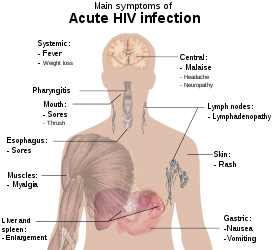AIDS Full Form: Acquired Immunodeficiency Syndrome is the full form of AIDS. AIDS is caused by Human Immunodeficiency Virus (HIV) and is the last stage of HIV infection. It is a virus transmitted disease that causes the body to lose its natural immunity against infection.
AIDS Full Form
The AIDS epidemic began in the United States in the 1980s. The World Health Organization (WHO) Trusted Source estimates more than 35 million people have died from the condition.
Effects on the immune system
HIV results in weakening the immune system by attacking host T cells (also known as CD4 cells) and certain White Blood Cells and reduces the body’s resistance to disease.
HIV tends to multiply inside the host cells, destroying them. A CD4 count indicates the fitness level of one’s immune system. A CD4 count between 500-1500 indicates a healthy immune system. If the CD4 count of an HIV-infected person falls below 200, the person is likely to experience symptoms of illness. HIV could lead to stage 3 HIV or AIDS with no medical treatment.
Transmission of HIV
HIV is transmitted through the exchange of certain bodily fluids with any HIV infected person, such as:
- During sexual contact, HIV can be transmitted by exchanging certain fluids like blood, semen, anal and vaginal secretions, or other sexually transmitted infections (STIs).
- Needles and syringes used by a person with HIV may contain the virus. This virus can be transmitted if this equipment comes in contact with any person.
- The virus can be transmitted to an infant before or after birth by the mother having HIV, during pregnancy, at delivery, or during breastfeeding.
AIDS may be prevented by avoiding the transmission of the virus through the ways mentioned above.
Symptoms of AIDS
- Rapid weight loss
- Repeated fever or profuse night sweats
- Extreme fatigue with no valid reason
- Prolonged swelling of the glands
- Diarrhea lasting for more than a week
- Sore throat
- Pneumonia
- Rashes on skin
- Memory loss, depression, and other neurologic disorders
Each of these symptoms may be related to other illnesses. The only way to ensure if one has HIV is to get tested by using either a blood or an oral specimen.

Treatment for AIDS
There is no cure for Acquired Immunodeficiency Syndrome (Full form of AIDS). The current antiretroviral treatment helps people living with HIV prevent its progression and live normal life spans.
With no HIV medicine, people with AIDS survive about three years. Once someone suffers from a dangerous opportunistic illness, life expectancy without treatment falls to about 1 year.
The time between infection with HIV and the onset of AIDS can vary widely between individuals. The period between acquiring HIV and the onset of AIDS usually ranges between 10-15 years or longer. The majority of HIV-infected people develop symptoms of HIV-related illness within 5-10 years or shorter.
Conclusion
AIDS Full Form is Acquired Immunodeficiency Syndrome. It is caused by Human Immunodeficiency Virus (HIV) and is the last stage of HIV infection. AIDS is a virus transmitted disease that causes the body to lose its natural immunity against infection.
Here in this post, we have explained everything about AIDS in detail.
People Also Reading:
